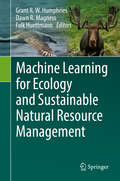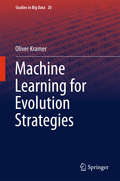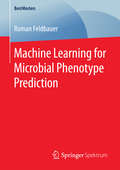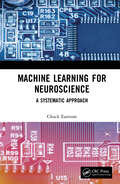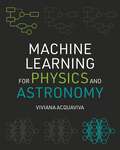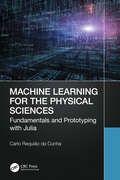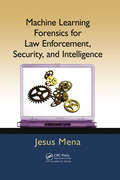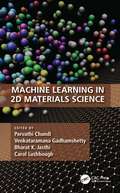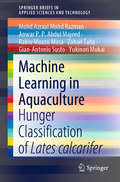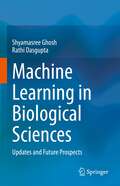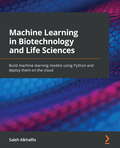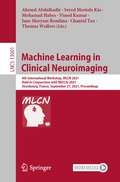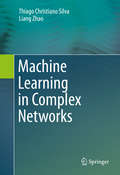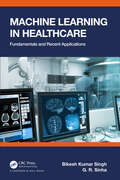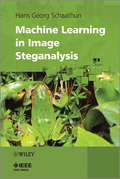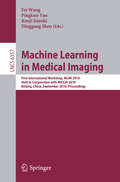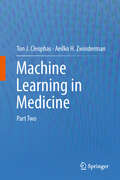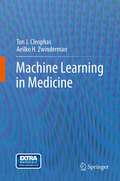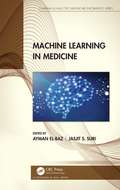- Table View
- List View
Machine Learning for Ecology and Sustainable Natural Resource Management
by Dawn R. Magness Falk Huettmann Grant HumphriesEcologists and natural resource managers are charged with making complex management decisions in the face of a rapidly changing environment resulting from climate change, energy development, urban sprawl, invasive species and globalization. Advances in Geographic Information System (GIS) technology, digitization, online data availability, historic legacy datasets, remote sensors and the ability to collect data on animal movements via satellite and GPS have given rise to large, highly complex datasets. These datasets could be utilized for making critical management decisions, but are often “messy” and difficult to interpret. Basic artificial intelligence algorithms (i.e., machine learning) are powerful tools that are shaping the world and must be taken advantage of in the life sciences. In ecology, machine learning algorithms are critical to helping resource managers synthesize information to better understand complex ecological systems. Machine Learning has a wide variety of powerful applications, with three general uses that are of particular interest to ecologists: (1) data exploration to gain system knowledge and generate new hypotheses, (2) predicting ecological patterns in space and time, and (3) pattern recognition for ecological sampling. Machine learning can be used to make predictive assessments even when relationships between variables are poorly understood. When traditional techniques fail to capture the relationship between variables, effective use of machine learning can unearth and capture previously unattainable insights into an ecosystem's complexity. Currently, many ecologists do not utilize machine learning as a part of the scientific process. This volume highlights how machine learning techniques can complement the traditional methodologies currently applied in this field.
Machine Learning for Evolution Strategies (Studies in Big Data #20)
by Oliver KramerThis book introduces numerous algorithmic hybridizations between both worlds that show how machine learning can improve and support evolution strategies. The set of methods comprises covariance matrix estimation, meta-modeling of fitness and constraint functions, dimensionality reduction for search and visualization of high-dimensional optimization processes, and clustering-based niching. After giving an introduction to evolution strategies and machine learning, the book builds the bridge between both worlds with an algorithmic and experimental perspective. Experiments mostly employ a (1+1)-ES and are implemented in Python using the machine learning library scikit-learn. The examples are conducted on typical benchmark problems illustrating algorithmic concepts and their experimental behavior. The book closes with a discussion of related lines of research.
Machine Learning for Microbial Phenotype Prediction (BestMasters)
by Roman FeldbauerThis thesis presents a scalable, generic methodology for microbial phenotype prediction based on supervised machine learning, several models for biological and ecological traits of high relevance, and the deployment in metagenomic datasets. The results suggest that the presented prediction tool can be used to automatically annotate phenotypes in near-complete microbial genome sequences, as generated in large numbers in current metagenomic studies. Unraveling relationships between a living organism's genetic information and its observable traits is a central biological problem. Phenotype prediction facilitated by machine learning techniques will be a major step forward to creating biological knowledge from big data.
Machine Learning for Neuroscience: A Systematic Approach
by Chuck EasttomThis book addresses the growing need for machine learning and data mining in neuroscience. The book offers a basic overview of the neuroscience, machine learning and the required math and programming necessary to develop reliable working models. The material is presented in a easy to follow user-friendly manner and is replete with fully working machine learning code. Machine Learning for Neuroscience: A Systematic Approach, tackles the needs of neuroscience researchers and practitioners that have very little training relevant to machine learning. The first section of the book provides an overview of necessary topics in order to delve into machine learning, including basic linear algebra and Python programming. The second section provides an overview of neuroscience and is directed to the computer science oriented readers. The section covers neuroanatomy and physiology, cellular neuroscience, neurological disorders and computational neuroscience. The third section of the book then delves into how to apply machine learning and data mining to neuroscience and provides coverage of artificial neural networks (ANN), clustering, and anomaly detection. The book contains fully working code examples with downloadable working code. It also contains lab assignments and quizzes, making it appropriate for use as a textbook. The primary audience is neuroscience researchers who need to delve into machine learning, programmers assigned neuroscience related machine learning projects and students studying methods in computational neuroscience.
Machine Learning for Neuroscience: A Systematic Approach
by Chuck EasttomThis book addresses the growing need for machine learning and data mining in neuroscience. The book offers a basic overview of the neuroscience, machine learning and the required math and programming necessary to develop reliable working models. The material is presented in a easy to follow user-friendly manner and is replete with fully working machine learning code. Machine Learning for Neuroscience: A Systematic Approach, tackles the needs of neuroscience researchers and practitioners that have very little training relevant to machine learning. The first section of the book provides an overview of necessary topics in order to delve into machine learning, including basic linear algebra and Python programming. The second section provides an overview of neuroscience and is directed to the computer science oriented readers. The section covers neuroanatomy and physiology, cellular neuroscience, neurological disorders and computational neuroscience. The third section of the book then delves into how to apply machine learning and data mining to neuroscience and provides coverage of artificial neural networks (ANN), clustering, and anomaly detection. The book contains fully working code examples with downloadable working code. It also contains lab assignments and quizzes, making it appropriate for use as a textbook. The primary audience is neuroscience researchers who need to delve into machine learning, programmers assigned neuroscience related machine learning projects and students studying methods in computational neuroscience.
Machine Learning for Physics and Astronomy
by Viviana AcquavivaA hands-on introduction to machine learning and its applications to the physical sciencesAs the size and complexity of data continue to grow exponentially across the physical sciences, machine learning is helping scientists to sift through and analyze this information while driving breathtaking advances in quantum physics, astronomy, cosmology, and beyond. This incisive textbook covers the basics of building, diagnosing, optimizing, and deploying machine learning methods to solve research problems in physics and astronomy, with an emphasis on critical thinking and the scientific method. Using a hands-on approach to learning, Machine Learning for Physics and Astronomy draws on real-world, publicly available data as well as examples taken directly from the frontiers of research, from identifying galaxy morphology from images to identifying the signature of standard model particles in simulations at the Large Hadron Collider.Introduces readers to best practices in data-driven problem-solving, from preliminary data exploration and cleaning to selecting the best method for a given taskEach chapter is accompanied by Jupyter Notebook worksheets in Python that enable students to explore key conceptsIncludes a wealth of review questions and quizzesIdeal for advanced undergraduate and early graduate students in STEM disciplines such as physics, computer science, engineering, and applied mathematicsAccessible to self-learners with a basic knowledge of linear algebra and calculusSlides and assessment questions (available only to instructors)
Machine Learning for the Physical Sciences: Fundamentals and Prototyping with Julia
by Carlo Requião da CunhaMachine learning is an exciting topic with a myriad of applications. However, most textbooks are targeted towards computer science students. This, however, creates a complication for scientists across the physical sciences that also want to understand the main concepts of machine learning and look ahead to applica- tions and advancements in their fields. This textbook bridges this gap, providing an introduction to the mathematical foundations for the main algorithms used in machine learning for those from the physical sciences, without a formal background in computer science. It demon- strates how machine learning can be used to solve problems in physics and engineering, targeting senior undergraduate and graduate students in physics and electrical engineering, alongside advanced researchers. Key Features: Includes detailed algorithms Supplemented by codes in Julia: a high-performing language and one that is easy to read for those in the natural sciences All algorithms are presented with a good mathematical background
Machine Learning for the Physical Sciences: Fundamentals and Prototyping with Julia
by Carlo Requião da CunhaMachine learning is an exciting topic with a myriad of applications. However, most textbooks are targeted towards computer science students. This, however, creates a complication for scientists across the physical sciences that also want to understand the main concepts of machine learning and look ahead to applica- tions and advancements in their fields. This textbook bridges this gap, providing an introduction to the mathematical foundations for the main algorithms used in machine learning for those from the physical sciences, without a formal background in computer science. It demon- strates how machine learning can be used to solve problems in physics and engineering, targeting senior undergraduate and graduate students in physics and electrical engineering, alongside advanced researchers. Key Features: Includes detailed algorithms Supplemented by codes in Julia: a high-performing language and one that is easy to read for those in the natural sciences All algorithms are presented with a good mathematical background
Machine Learning Forensics for Law Enforcement, Security, and Intelligence
by Jesus MenaIncreasingly, crimes and fraud are digital in nature, occurring at breakneck speed and encompassing large volumes of data. To combat this unlawful activity, knowledge about the use of machine learning technology and software is critical. Machine Learning Forensics for Law Enforcement, Security, and Intelligence integrates an assortment of deductive
Machine Learning Forensics for Law Enforcement, Security, and Intelligence
by Jesus MenaIncreasingly, crimes and fraud are digital in nature, occurring at breakneck speed and encompassing large volumes of data. To combat this unlawful activity, knowledge about the use of machine learning technology and software is critical. Machine Learning Forensics for Law Enforcement, Security, and Intelligence integrates an assortment of deductive
Machine Learning in 2D Materials Science
by Parvathi ChundiData science and machine learning (ML) methods are increasingly being used to transform the way research is being conducted in materials science to enable new discoveries and design new materials. For any materials science researcher or student, it may be daunting to figure out if ML techniques are useful for them or, if so, which ones are applicable in their individual contexts, and how to study the effectiveness of these methods systematically. KEY FEATURES • Provides broad coverage of data science and ML fundamentals to materials science researchers so that they can confidently leverage these techniques in their research projects. • Offers introductory material in topics such as ML, data integration, and 2D materials. • Provides in-depth coverage of current ML methods for validating 2D materials using both experimental and simulation data, researching and discovering new 2D materials, and enhancing ML methods with physical properties of materials. • Discusses customized ML methods for 2D materials data and applications and high-throughput data acquisition. • Describes several case studies illustrating how ML approaches are currently leading innovations in the discovery, development, manufacturing, and deployment of 2D materials needed for strengthening industrial products. • Gives future trends in ML for 2D materials, explainable AI, and dealing with extremely large and small, diverse datasets. Aimed at materials science researchers, this book allows readers to quickly, yet thoroughly, learn the ML and AI concepts needed to ascertain the applicability of ML methods in their research.
Machine Learning in 2D Materials Science
Data science and machine learning (ML) methods are increasingly being used to transform the way research is being conducted in materials science to enable new discoveries and design new materials. For any materials science researcher or student, it may be daunting to figure out if ML techniques are useful for them or, if so, which ones are applicable in their individual contexts, and how to study the effectiveness of these methods systematically. KEY FEATURES • Provides broad coverage of data science and ML fundamentals to materials science researchers so that they can confidently leverage these techniques in their research projects. • Offers introductory material in topics such as ML, data integration, and 2D materials. • Provides in-depth coverage of current ML methods for validating 2D materials using both experimental and simulation data, researching and discovering new 2D materials, and enhancing ML methods with physical properties of materials. • Discusses customized ML methods for 2D materials data and applications and high-throughput data acquisition. • Describes several case studies illustrating how ML approaches are currently leading innovations in the discovery, development, manufacturing, and deployment of 2D materials needed for strengthening industrial products. • Gives future trends in ML for 2D materials, explainable AI, and dealing with extremely large and small, diverse datasets. Aimed at materials science researchers, this book allows readers to quickly, yet thoroughly, learn the ML and AI concepts needed to ascertain the applicability of ML methods in their research.
Machine Learning in Aquaculture: Hunger Classification of Lates calcarifer (SpringerBriefs in Applied Sciences and Technology)
by Zahari Taha Gian-Antonio Susto Yukinori Mukai Mohd Azraai Mohd Razman Anwar P. P. Abdul Majeed Rabiu Muazu MusaThis book highlights the fundamental association between aquaculture and engineering in classifying fish hunger behaviour by means of machine learning techniques. Understanding the underlying factors that affect fish growth is essential, since they have implications for higher productivity in fish farms. Computer vision and machine learning techniques make it possible to quantify the subjective perception of hunger behaviour and so allow food to be provided as necessary. The book analyses the conceptual framework of motion tracking, feeding schedule and prediction classifiers in order to classify the hunger state, and proposes a system comprising an automated feeder system, image-processing module, as well as machine learning classifiers. Furthermore, the system substitutes conventional, complex modelling techniques with a robust, artificial intelligence approach. The findings presented are of interest to researchers, fish farmers, and aquaculture technologist wanting to gain insights into the productivity of fish and fish behaviour.
Machine Learning in Biological Sciences: Updates and Future Prospects
by Shyamasree Ghosh Rathi DasguptaThis book gives an overview of applications of Machine Learning (ML) in diverse fields of biological sciences, including healthcare, animal sciences, agriculture, and plant sciences. Machine learning has major applications in process modelling, computer vision, signal processing, speech recognition, and language understanding and processing and life, and health sciences. It is increasingly used in understanding DNA patterns and in precision medicine. This book is divided into eight major sections, each containing chapters that describe the application of ML in a certain field. The book begins by giving an introduction to ML and the various ML methods. It then covers interesting and timely aspects such as applications in genetics, cell biology, the study of plant-pathogen interactions, and animal behavior. The book discusses computational methods for toxicity prediction of environmental chemicals and drugs, which forms a major domain of research in the field of biology. It is of relevance to post-graduate students and researchers interested in exploring the interdisciplinary areas of use of machine learning and deep learning in life sciences.
Machine Learning In Biotechnology And Life Sciences: Build Machine Learning Models Using Python And Deploy Them On The Cloud (pdf)
by Saleh AlkhalifaExplore all the tools and templates needed for data scientists to drive success in their biotechnology careers with this comprehensive guide Key Features Learn the applications of machine learning in biotechnology and life science sectors Discover exciting real-world applications of deep learning and natural language processing Understand the general process of deploying models to cloud platforms such as AWS and GCP Book Description The booming fields of biotechnology and life sciences have seen drastic changes over the last few years. With competition growing in every corner, companies around the globe are looking to data-driven methods such as machine learning to optimize processes and reduce costs. This book helps lab scientists, engineers, and managers to develop a data scientist's mindset by taking a hands-on approach to learning about the applications of machine learning to increase productivity and efficiency in no time. You'll start with a crash course in Python, SQL, and data science to develop and tune sophisticated models from scratch to automate processes and make predictions in the biotechnology and life sciences domain. As you advance, the book covers a number of advanced techniques in machine learning, deep learning, and natural language processing using real-world data. By the end of this machine learning book, you'll be able to build and deploy your own machine learning models to automate processes and make predictions using AWS and GCP. What you will learn Get started with Python programming and Structured Query Language (SQL) Develop a machine learning predictive model from scratch using Python Fine-tune deep learning models to optimize their performance for various tasks Find out how to deploy, evaluate, and monitor a model in the cloud Understand how to apply advanced techniques to real-world data Discover how to use key deep learning methods such as LSTMs and transformers Who this book is for This book is for data scientists and scientific professionals looking to transcend to the biotechnology domain. Scientific professionals who are already established within the pharmaceutical and biotechnology sectors will find this book useful. A basic understanding of Python programming and beginner-level background in data science conjunction is needed to get the most out of this book. Table of Contents Introducing Machine Learning for Biotechnology Introducing Python and the Command Line Getting Started with SQL and Relational Databases Visualizing Data with Python Understanding Machine Learning Unsupervised Machine Learning Supervised Machine Learning Understanding Deep Learning Natural Language Processing Exploring Time Series Analysis Deploying Models with Flask Applications Deploying Applications to the Cloud
Machine Learning in Clinical Neuroimaging: 4th International Workshop, MLCN 2021, Held in Conjunction with MICCAI 2021, Strasbourg, France, September 27, 2021, Proceedings (Lecture Notes in Computer Science #13001)
by Ahmed Abdulkadir Seyed Mostafa Kia Mohamad Habes Vinod Kumar Jane Maryam Rondina Chantal Tax Thomas WolfersThis book constitutes the refereed proceedings of the 4th International Workshop on Machine Learning in Clinical Neuroimaging, MLCN 2021, held on September 27, 2021, in conjunction with MICCAI 2021. The workshop was held virtually due to the COVID-19 pandemic. The 17 papers presented in this book were carefully reviewed and selected from 27 submissions. They were organized in topical sections named: computational anatomy and brain networks and time series.
Machine Learning in Complex Networks
by Thiago Christiano Silva Liang ZhaoThis book presents the features and advantages offered by complex networks in the machine learning domain. In the first part, an overview on complex networks and network-based machine learning is presented, offering necessary background material. In the second part, we describe in details some specific techniques based on complex networks for supervised, non-supervised, and semi-supervised learning. Particularly, a stochastic particle competition technique for both non-supervised and semi-supervised learning using a stochastic nonlinear dynamical system is described in details. Moreover, an analytical analysis is supplied, which enables one to predict the behavior of the proposed technique. In addition, data reliability issues are explored in semi-supervised learning. Such matter has practical importance and is not often found in the literature. With the goal of validating these techniques for solving real problems, simulations on broadly accepted databases are conducted. Still in this book, we present a hybrid supervised classification technique that combines both low and high orders of learning. The low level term can be implemented by any classification technique, while the high level term is realized by the extraction of features of the underlying network constructed from the input data. Thus, the former classifies the test instances by their physical features, while the latter measures the compliance of the test instances with the pattern formation of the data. We show that the high level technique can realize classification according to the semantic meaning of the data. This book intends to combine two widely studied research areas, machine learning and complex networks, which in turn will generate broad interests to scientific community, mainly to computer science and engineering areas.
Machine Learning in Healthcare: Fundamentals and Recent Applications
by Bikesh Kumar Singh G.R. SinhaArtificial intelligence (AI) and machine learning (ML) techniques play an important role in our daily lives by enhancing predictions and decision-making for the public in several fields such as financial services, real estate business, consumer goods, social media, etc. Despite several studies that have proved the efficacy of AI/ML tools in providing improved healthcare solutions, it has not gained the trust of health-care practitioners and medical scientists. This is due to poor reporting of the technology, variability in medical data, small datasets, and lack of standard guidelines for application of AI. Therefore, the development of new AI/ML tools for various domains of medicine is an ongoing field of research. Machine Learning in Healthcare: Fundamentals and Recent Applications discusses how to build various ML algorithms and how they can be applied to improve healthcare systems. Healthcare applications of AI are innumerable: medical data analysis, early detection and diagnosis of disease, providing objective-based evidence to reduce human errors, curtailing inter- and intra-observer errors, risk identification and interventions for healthcare management, real-time health monitoring, assisting clinicians and patients for selecting appropriate medications, and evaluating drug responses. Extensive demonstrations and discussion on the various principles of machine learning and its application in healthcare is provided, along with solved examples and exercises. This text is ideal for readers interested in machine learning without any background knowledge and looking to implement machine-learning models for healthcare systems.
Machine Learning in Healthcare: Fundamentals and Recent Applications
by Bikesh Kumar Singh G.R. SinhaArtificial intelligence (AI) and machine learning (ML) techniques play an important role in our daily lives by enhancing predictions and decision-making for the public in several fields such as financial services, real estate business, consumer goods, social media, etc. Despite several studies that have proved the efficacy of AI/ML tools in providing improved healthcare solutions, it has not gained the trust of health-care practitioners and medical scientists. This is due to poor reporting of the technology, variability in medical data, small datasets, and lack of standard guidelines for application of AI. Therefore, the development of new AI/ML tools for various domains of medicine is an ongoing field of research. Machine Learning in Healthcare: Fundamentals and Recent Applications discusses how to build various ML algorithms and how they can be applied to improve healthcare systems. Healthcare applications of AI are innumerable: medical data analysis, early detection and diagnosis of disease, providing objective-based evidence to reduce human errors, curtailing inter- and intra-observer errors, risk identification and interventions for healthcare management, real-time health monitoring, assisting clinicians and patients for selecting appropriate medications, and evaluating drug responses. Extensive demonstrations and discussion on the various principles of machine learning and its application in healthcare is provided, along with solved examples and exercises. This text is ideal for readers interested in machine learning without any background knowledge and looking to implement machine-learning models for healthcare systems.
Machine Learning in Image Steganalysis (Wiley - IEEE)
by Hans Georg SchaathunSteganography is the art of communicating a secret message, hiding the very existence of a secret message. This book is an introduction to steganalysis as part of the wider trend of multimedia forensics, as well as a practical tutorial on machine learning in this context. It looks at a wide range of feature vectors proposed for steganalysis with performance tests and comparisons. Python programs and algorithms are provided to allow readers to modify and reproduce outcomes discussed in the book.
Machine Learning in Image Steganalysis (Wiley - IEEE)
by Hans Georg SchaathunSteganography is the art of communicating a secret message, hiding the very existence of a secret message. This book is an introduction to steganalysis as part of the wider trend of multimedia forensics, as well as a practical tutorial on machine learning in this context. It looks at a wide range of feature vectors proposed for steganalysis with performance tests and comparisons. Python programs and algorithms are provided to allow readers to modify and reproduce outcomes discussed in the book.
Machine Learning in Medical Imaging: First International Workshop, MLMI 2010, Held in Conjunction with MICCAI 2010, Beijing, China, September 20, 2010, Proceedings (Lecture Notes in Computer Science #6357)
by Fei Wang Pingkun Yan Kenji Suzuki Dinggang ShenThe first International Workshop on Machine Learning in Medical Imaging, MLMI 2010, was held at the China National Convention Center, Beijing, China on Sept- ber 20, 2010 in conjunction with the International Conference on Medical Image Computing and Computer Assisted Intervention (MICCAI) 2010. Machine learning plays an essential role in the medical imaging field, including image segmentation, image registration, computer-aided diagnosis, image fusion, ima- guided therapy, image annotation, and image database retrieval. With advances in me- cal imaging, new imaging modalities, and methodologies such as cone-beam/multi-slice CT, 3D Ultrasound, tomosynthesis, diffusion-weighted MRI, electrical impedance to- graphy, and diffuse optical tomography, new machine-learning algorithms/applications are demanded in the medical imaging field. Single-sample evidence provided by the patient’s imaging data is often not sufficient to provide satisfactory performance; the- fore tasks in medical imaging require learning from examples to simulate a physician’s prior knowledge of the data. The MLMI 2010 is the first workshop on this topic. The workshop focuses on major trends and challenges in this area, and works to identify new techniques and their use in medical imaging. Our goal is to help advance the scientific research within the broad field of medical imaging and machine learning. The range and level of submission for this year's meeting was of very high quality. Authors were asked to submit full-length papers for review. A total of 38 papers were submitted to the workshop in response to the call for papers.
Machine Learning in Medicine: Part Two
by Ton J. Cleophas Aeilko H. ZwindermanMachine learning is concerned with the analysis of large data and multiple variables. However, it is also often more sensitive than traditional statistical methods to analyze small data. The first volume reviewed subjects like optimal scaling, neural networks, factor analysis, partial least squares, discriminant analysis, canonical analysis, and fuzzy modeling. This second volume includes various clustering models, support vector machines, Bayesian networks, discrete wavelet analysis, genetic programming, association rule learning, anomaly detection, correspondence analysis, and other subjects. Both the theoretical bases and the step by step analyses are described for the benefit of non-mathematical readers. Each chapter can be studied without the need to consult other chapters. Traditional statistical tests are, sometimes, priors to machine learning methods, and they are also, sometimes, used as contrast tests. To those wishing to obtain more knowledge of them, we recommend to additionally study (1) Statistics Applied to Clinical Studies 5th Edition 2012, (2) SPSS for Starters Part One and Two 2012, and (3) Statistical Analysis of Clinical Data on a Pocket Calculator Part One and Two 2012, written by the same authors, and edited by Springer, New York.
Machine Learning in Medicine
by Ton J. Cleophas Aeilko H. ZwindermanMachine learning is a novel discipline concerned with the analysis of large and multiple variables data. It involves computationally intensive methods, like factor analysis, cluster analysis, and discriminant analysis. It is currently mainly the domain of computer scientists, and is already commonly used in social sciences, marketing research, operational research and applied sciences. It is virtually unused in clinical research. This is probably due to the traditional belief of clinicians in clinical trials where multiple variables are equally balanced by the randomization process and are not further taken into account. In contrast, modern computer data files often involve hundreds of variables like genes and other laboratory values, and computationally intensive methods are required. This book was written as a hand-hold presentation accessible to clinicians, and as a must-read publication for those new to the methods.
Machine Learning in Medicine (Chapman & Hall/CRC Healthcare Informatics Series)
by Ayman El-Baz Jasjit S. SuriMachine Learning in Medicine covers the state-of-the-art techniques of machine learning and their applications in the medical field. It presents several computer-aided diagnosis (CAD) systems, which have played an important role in the diagnosis of several diseases in the past decade, e.g., cancer detection, resulting in the development of several successful systems. New developments in machine learning may make it possible in the near future to develop machines that are capable of completely performing tasks that currently cannot be completed without human aid, especially in the medical field. This book covers such machines, including convolutional neural networks (CNNs) with different activation functions for small- to medium-size biomedical datasets, detection of abnormal activities stemming from cognitive decline, thermal dose modelling for thermal ablative cancer treatments, dermatological machine learning clinical decision support systems, artificial intelligence-powered ultrasound for diagnosis, practical challenges with possible solutions for machine learning in medical imaging, epilepsy diagnosis from structural MRI, Alzheimer's disease diagnosis, classification of left ventricular hypertrophy, and intelligent medical language understanding. This book will help to advance scientific research within the broad field of machine learning in the medical field. It focuses on major trends and challenges in this area and presents work aimed at identifying new techniques and their use in biomedical analysis, including extensive references at the end of each chapter.
